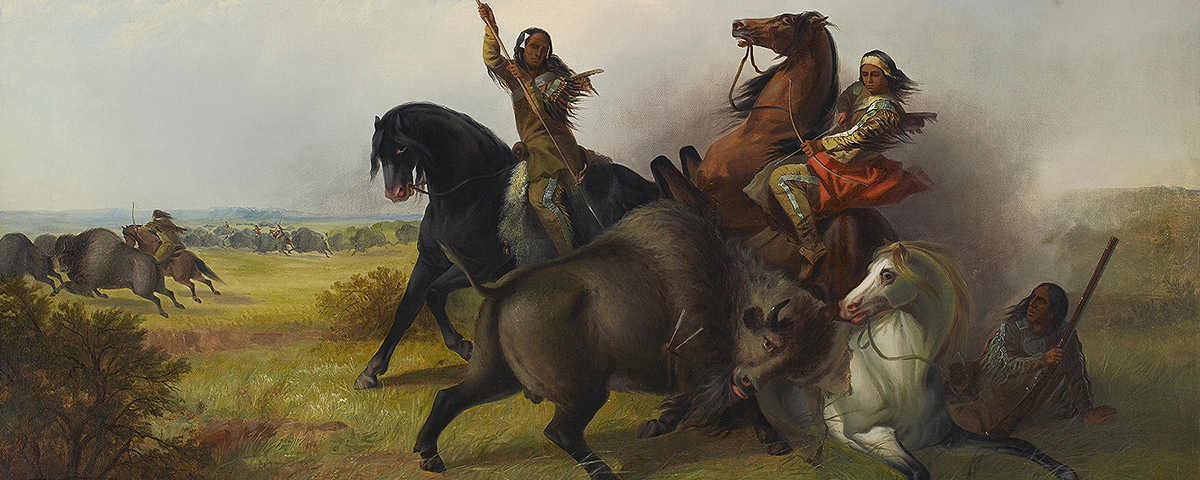When Mindy Besaw left the Whitney Western Art Museum in Cody, Wyo., last year to become curator for the Crystal Bridges Museum of American Art in Bentonville, Ark., she moved to the East, but she didn’t leave the West behind. “Artists like Charles Bird King, John Mix Stanley, Frederic Remington and Georgia O’Keeffe weren’t just Western artists, they were American artists,” explains Besaw, who also focused on Western art while curating at the Denver Art Museum.
Among the first exhibits Besaw helped curate at Crystal Bridges was the recently ended “Changing Perspectives of Native Americans,” and museumgoers will find works by King, Stanley, Remington and O’Keeffe, as well as Albert Bierstadt, George Catlin, Thomas Cole and Worthington Whittredge. Their Western portraits and landscapes hang alongside the canvases of such masters as John James Audubon, Norman Rockwell and Andy Warhol.
Opened in November 2011, the museum is the dream of Alice Walton, daughter of Walmart founder Sam Walton. It sits on 120 acres and is named for a nearby spring and the on-site bridges that span spring-fed ponds. Israeli-born international architect Moshe Safdie designed the main building, and Arkansas architect Marlon Blackwell designed the museum store, both of which are visually arresting. Walking trails connect the museum grounds with downtown Bentonville.
The museum is a repository of art research and masterworks. Its library houses more than 50,000 volumes, while its permanent galleries present a chronological history of American art that spans five centuries and shows the transformation of artistic styles. Take, for example, the draped robes and Greek and Roman stances—“The classical idea of beauty,” Besaw notes—in King’s oil on panel portraits of an Otoe chief (circa 1822) and a Sauk chief (circa 1824). Between 1822 and 1842 King rendered more than 140 portraits of Indians for Thomas McKenney, the first superintendent of Indian Affairs. An 1865 fire at the Smithsonian Institution destroyed most of the artist’s original portraits.
Compare King’s romantic vision of the West—or George de Forest Brush’s The Indian and the Lily, Catlin’s Indian Encampment or Stanley’s The Buffalo Hunt—with, say, Remington’s nocturnal 1906 oil on canvas Cowpuncher’s Lullaby or the 1914 bronze On the Warpath, by Cyrus Edwin Dallin, a Utah native who drew his inspiration from watching Buffalo Bill Cody’s Wild West traveling show in Paris in 1889. Or skip several steps ahead to the photo-realism of Cobi Moules’ Untitled (Avalanche Lake), a 2012 oil on canvas.
The oldest painting in the museum collection is James Wooldridge’s Indians of Virginia, which Wooldridge painted circa 1675. The artist’s vision of Virginia is pure fantasy. “He was a British painter,” Besaw explains, “who never came here.” Among other early treasures is a Charles Wilson Peale portrait of George Washington.
Walton’s dream is far from realized, as the museum regularly acquires new works, including a set of more than 700 Edward Curtis photographs and O’Keeffe’s 1932 oil-on-canvas Jimson Weed/White Flower No. 1. The museum also co-owns (with Fisk University in Nashville, Tenn.) the Alfred Stieglitz Collection, featuring 101 works, including O’Keeffe’s oils-on-canvas Radiator Building—Night New York (1927) and Flying Backbone (1944), both of which the artist painted while married to Stieglitz.
With 500 years of art already to choose from, can Besaw pick a favorite work? “That’s like choosing a favorite child,” says the curator. “But it depends on the day. If it’s a day like today, I might choose The Indian and the Lily. But tomorrow…?”
Meanwhile, Crystal Bridges continues its eclectic mission. American Made: Treasures From the American Folk Art Museum, a collaborative exhibit between Crystal Bridges and New York’s American Folk Art Museum, is scheduled to run July 2 through September 19. The Art of American Dance: 1830–1960, organized by the Detroit Institute of Arts as the first major traveling exhibition focused on visual art related to American dance forms, is scheduled to run October 22 through Jan. 17, 2017. WW





